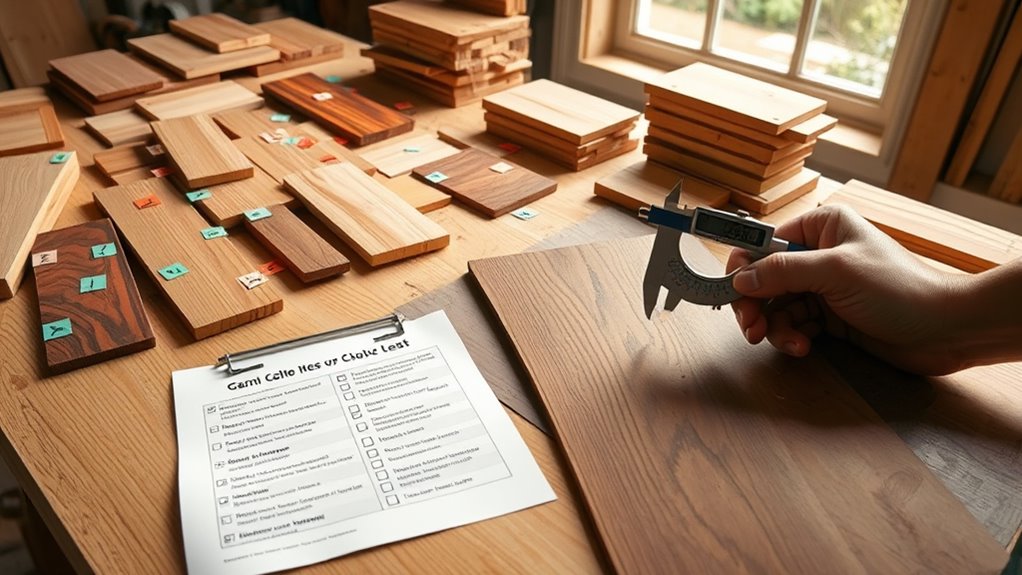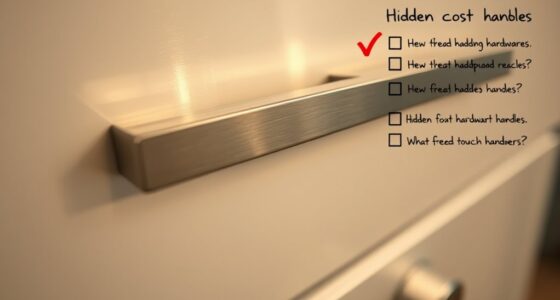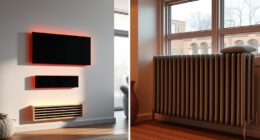To master cedar versus hemlock in a weekend, start by clarifying your project needs, considering aesthetics, durability, and environmental impact. Compare their grain patterns, color tones, and how they age over time. Factor in your budget, noting cedar’s higher cost but longer lifespan, versus hemlock’s affordability and easier handling. Prioritize what matters most—appearance, sustainability, or cost—and keep a checklist handy. If you continue, you’ll discover how to align choices with your project goals effectively.
Key Takeaways
- Clarify your project’s aesthetic goals and environmental priorities to determine which wood aligns best.
- Compare grain patterns and color variations to match your desired visual style.
- Assess durability needs and climate conditions to select the most suitable material.
- Consider cost differences and long-term maintenance implications for budget planning.
- Conduct quick sample tests of cedar and hemlock to evaluate appearance, workability, and weather resistance.
Assessing Project Requirements and Priorities

Before choosing between cedar and hemlock, you need to clearly understand your project’s specific requirements and priorities. Consider how the grain patterns will affect the final appearance; cedar often has a more distinct, reddish grain, while hemlock’s grain is softer and more uniform. Think about the environmental impact, too—cedar is generally more sustainable due to its slow growth and durability, reducing the need for frequent replacements. Your decision should align with your goals for longevity, aesthetics, and eco-friendliness. Clarify whether you prioritize natural beauty, environmental responsibility, or cost-efficiency. Additionally, understanding the material durability of each wood type can help ensure your choice withstands the conditions it will face. By evaluating these factors upfront, you’ll better determine which wood type suits your project, avoiding surprises and ensuring your material choice supports your overall vision.
Comparing Key Characteristics and Cost Factors

When comparing cedar and hemlock, understanding their key characteristics and cost implications is essential for making an informed decision. Cedar typically features prominent grain patterns that create a rich, textured appearance, and it often exhibits warm color variations, ranging from reddish-browns to golden hues. Hemlock, on the other hand, has a more uniform grain pattern with a lighter, pale color and subtle variations, offering a softer look. Cost-wise, cedar tends to be more expensive due to its durability and aesthetic appeal, while hemlock is generally more budget-friendly and easier to work with. Considering these factors helps you choose the right material based on your visual preferences, project durability needs, and budget constraints. Additionally, color consistency plays a significant role in achieving a uniform appearance across your project.
Frequently Asked Questions
Which Wood Is More Environmentally Sustainable for Outdoor Projects?
You should choose cedar, as it’s generally more environmentally sustainable for outdoor projects. Cedar often comes from forests managed with sustainable forestry practices, ensuring responsible harvesting. Plus, it can be treated with eco-friendly treatments that reduce environmental impact. Hemlock, while durable, may not always be sourced sustainably. Opting for cedar supports eco-conscious choices and promotes healthier forests, making it the better option for environmentally friendly outdoor construction.
How Do Cedar and Hemlock Perform in High-Moisture Environments?
A wise man once said, “Forewarned is forearmed.” Cedar outperforms hemlock in high-moisture environments because it offers superior moisture resistance and rot resistance. Cedar’s natural oils help prevent decay, making it ideal for outdoor projects exposed to humidity. Hemlock, on the other hand, absorbs more moisture and is less resistant to rot. If longevity in damp conditions matters, cedar’s your best bet.
Are There Specific Tools Recommended for Working With Each Wood Type?
You’ll want specific tools for each wood type. Use sharp saw blades designed for softwoods like cedar and hemlock to get clean cuts. For sanding, choose sanding tools with finer grits to avoid tearing the fibers, especially with cedar’s delicate surface. A miter saw or circular saw with a fine-tooth blade works well for both woods, but always adjust your blade and sanding grit based on the wood’s hardness and finish desired.
How Do Finishing Options Differ Between Cedar and Hemlock?
When choosing finishing options, you’ll find cedar often benefits from stain and sealant techniques that highlight its rich, reddish hue, enhancing its natural beauty and aesthetic appeal. Hemlock, on the other hand, responds well to clear finishes or light stains that preserve its pale, smooth appearance. Your goal should be to select finishing techniques that complement each wood’s unique grain and color, ensuring a durable, attractive result.
Which Wood Type Offers Better Long-Term Durability With Minimal Maintenance?
You’ll find cedar is like a seasoned warrior, offering better long-term durability with natural rot resistance that withstands the elements with minimal maintenance. Hemlock, though more affordable, doesn’t hold up as well against rot and requires more upkeep over time. For a cost comparison, cedar’s initial price is higher but saves you money on repairs and replacements later, making it the smarter choice for lasting strength.
Conclusion
By now, you’ve got a clear idea of how cedar and hemlock stack up for your project. Remember, “the best choice depends on your needs,” so weigh durability, cost, and appearance carefully. With this checklist in hand, you’re ready to make an informed decision this weekend. Trust your instincts, and don’t rush—sometimes, haste makes waste. Your perfect material match is just a checklist away!









